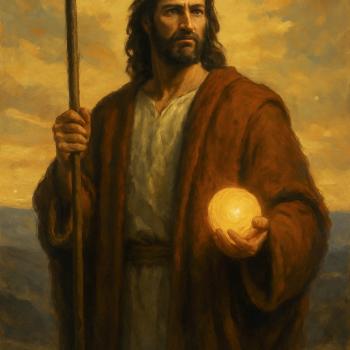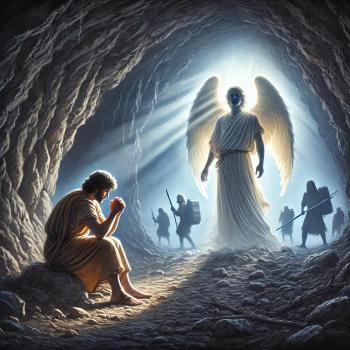Revelation 1:1-8 The Beginning of the End
THE SEVEN PARTS OF SALUTATION (GREETING) IN REVELATION
This section is called a prologue. A prologue is an introduction. In this case, one is being introduced to the last book of the Bible, and more important the final revelation of God in Jesus Christ. I want you to notice that the numbers seven and three come up over and over again in this book. Even in this sermon series, we will address things mostly in a pattern of sevens. So let’s start with the seven part of the greeting in Revelation 1:1-8.
The Revelation (Revelation 1:1)
“The revelation of Jesus Christ…” (Revelation 1:1, HCSB)
A revelation is an “unveiling.” Something which was hidden is now being opened. This is called the revelation of Jesus Christ about the future.
The Transmission (Revelation 1:1-3)
“The revelation of Jesus Christ that God gave Him to show His slaves what must quickly take place. He sent it and signified it through His angel to His slave John, who testified to God’s word and to the testimony about Jesus Christ, in all he saw. The one who reads this is blessed, and those who hear the words of this prophecy and keep what is written in it are blessed, because the time is near!” (Revelation 1:1–3, HCSB)
This revelation is passed on through different people (Revelation 1:1-3):
God – Jesus – Angel – John – the reader, the hearer, the keeper
Either this is a transmission through seven people (the reader, hearer, and keeper are different people). Or this is a transmission to a five people and one person does three actions (reads, hears, and keeps). Either way, you have the pattern of seven or three.
The revelation is sent and signified.
“…He sent it and signified it through His angel…” (Revelation 1:1, HCSB)
This means that the book is written using symbols. The Book of Revelation cannot be interpreted literally in a scientific sense. The book comes in three parts as mentioned in Revelation 1:19 later:
“Therefore write what you have seen, what is, and what will take place after this.” (Revelation 1:19, HCSB)
THREE PARTS TO THE BOOK OF REVELATION
- An introductory prologue
-
An epistle to seven churches
-
A set of visions
The Book of Revelation can be compared to a movie trailer. You see the highlights of a movie, but you can’t know all of the plot in the few scenes it shows. Revelation can be viewed as a set of scenes with symbolic meaning. This symbolic meaning is interpreted throughout the book. As the reader, we walk through these scenes.
The book is about events that will take place “soon.”
“…what must quickly take place…” (Revelation 1:1, HCSB)
What does “quickly” or “soon” mean? It can mean immediately as soon in time. What we call in prophecy imminent – nothing can precede it for the events to happen. The word also has the meaning that these things which we will see happen in quick rapid-fire succession.
The Blessing (Revelation 1:3)
“The one who reads this is blessed, and those who hear the words of this prophecy and keep what is written in it are blessed, because the time is near!” (Revelation 1:3, HCSB)
To the original audience, the scenes probably had significance because they were going through persecution. This book shared hope to help them through their time of difficult tribulation. This is why the person who reads the book and the one who hears and obeys the words of prophecy is blessed.
You will find seven blessings or Beatitudes in the book of Revelation. They are all blessings for those who are Christians. These blessings include the following:
SEVEN BLESSINGS FOR THE CHRISTIAN IN THE BOOK OF REVELATION
1. The reader of the book of Revelation
“The one who reads this is blessed, and those who hear the words of this prophecy and keep what is written in it are blessed, because the time is near!” (Revelation 1:3, HCSB)
2. Those who die in the Lord in the midst of the Great Tribulation
“Then I heard a voice from heaven saying, “Write: The dead who die in the Lord from now on are blessed.” “Yes,” says the Spirit, “let them rest from their labors, for their works follow them!”” (Revelation 14:13, HCSB)
3. Those who are alert when Jesus returns
““Look, I am coming like a thief. The one who is alert and remains clothed so that he may not go around naked and people see his shame is blessed.”” (Revelation 16:15, HCSB)
4. Those who are invited to the Marriage Supper of the Lamb
“Then he said to me, “Write: Those invited to the marriage feast of the Lamb are fortunate!” He also said to me, “These words of God are true.”” (Revelation 19:9, HCSB)
5. Those who share in the first resurrection
“Blessed and holy is the one who shares in the first resurrection! The second death has no power over them, but they will be priests of God and of the Messiah, and they will reign with Him for 1,000 years.” (Revelation 20:6, HCSB)
6. Those who keep the words of the book of Revelation
““Look, I am coming quickly! The one who keeps the prophetic words of this book is blessed.”” (Revelation 22:7, HCSB)
7. Those who have the right to the tree of life and may enter Heaven
““Blessed are those who wash their robes, so that they may have the right to the tree of life and may enter the city by the gates.” (Revelation 22:14, HCSB)
The Audience (Revelation 1:4)
“John: To the seven churches in Asia…” (Revelation 1:4, HCSB)
We are introduced to John, who received this set of visions. He sends it to the seven churches in Asia (Revelation 1:4). There are seven churches which he planted, but seven is also a number of completed perfection on the Bible. These churches form a circle when one leaves the island of Patmos. When one starts at Ephesus, the circles go in a circle. The letters were sent through a postal route to be read why John was exiled to the island of Patmos. Symbolically, John is communicating that the church is perfect (even though Jesus will later talk about problems in each of the churches). It is perfect because the church, though flawed, will complete God’s plan.
The Trinitarian Greeting (Revelation 1:4-5)
“…Grace and peace to you from the One who is, who was, and who is coming; from the seven spirits before His throne; and from Jesus Christ, the faithful witness, the firstborn from the dead and the ruler of the kings of the earth. To Him who loves us and has set us free from our sins by His blood,” (Revelation 1:4–5, HCSB)
John addresses the churches with a Trinitarian greeting:
- God the Father is the One who is, who was, and who is coming
This attribute of God probably comes from Isaiah 48:12 in which God describes His eternal nature:
““Listen to Me, Jacob, and Israel, the one called by Me: I am He; I am the first, I am also the last.” (Isaiah 48:12, HCSB)
- The Holy Spirit is the Seven-fold Spirt before the throne.
This points to another passage in the Old Testament which shows why the seven-fold Spirit are not angels, but the Holy Spirit:
“The Spirit of the Lord will rest on Him — a Spirit of wisdom and understanding, a Spirit of counsel and strength, a Spirit of knowledge and of the fear of the Lord.” (Isaiah 11:2, HCSB)
I realize that in your translation, there are only six characteristics. This uses a form of parallelism which happens in the Hebrew writings. They coupled characteristics together like “kissing cousins.” However, in the Greek translation of the Old Testament (which Jesus used), there are seven characteristics of the Holy Spirit in Isaiah 11:2.1
“and the Spirit of God shall rest upon him, the spirit of wisdom and understanding, the spirit of counsel and strength, the spirit of knowledge and godliness shall fill him;” (Isaiah 11:2, Brenton LXX En)
There are also seven ministries of the Holy Spirit in Isaiah 11:3-5. These actions that will take place in Revelation. The seem to influence the picture of Jesus in Revelation 1:16.
THE SEVEN-FOLD ACTION OF THE HOLY SPIRIT
- He will delight in the Lord
“His delight will be in the fear of the Lord….”(Isaiah 11:3, HCSB)
- He will judge the poor rightly
“but He will judge the poor righteously…” (Isaiah 11:4, HCSB)
- He will execute justice on the oppressed
“…execute justice for the oppressed of the land…” (Isaiah 11:4, HCSB)
- He will strike the land
“…He will strike the land with discipline from His mouth…” (Isaiah 11:4, HCSB)
- He will kill the wicked
“…and He will kill the wicked with a command from His lips.” (Isaiah 11:4, HCSB)
- He will be righteous
“Righteousness will be a belt around His loins…” (Isaiah 11:5, HCSB)
- He will be faithful
“…faithfulness will be a belt around His waist.” (Isaiah 11:5, HCSB)
- Jesus is addressed in a Trinitarian fashion (Revelation 1:5):
“and from Jesus Christ, the faithful witness, the firstborn from the dead and the ruler of the kings of the earth…” (Revelation 1:5, HCSB)
He is the faithful “martyr”
He is the “prototype” – the pre-eminate, or prominent over the dead
He is the arch-ruler of all the rulers on the Earth
Each of these descriptions about Jesus describes the authority of Jesus. He is over all of God’s children, all of the dead, and all of the those who lead the world.
The Prayer of Praise (Revelation 1:5-6)
“…To Him who loves us and has set us free from our sins by His blood, and made us a kingdom, priests to His God and Father—the glory and dominion are His forever and ever. Amen.” (Revelation 1:5–6, HCSB)
Revelation 1:5-6 continues the description of Jesus, but ends in a prayer dedicated to Jesus. Since this is the revelation of Jesus Christ, it is natural that He will be honored and lifted up. Jesus shares the praise with God the Father. Why is the Holy Spirit (or the seven-fold Spirit) not mentioned? Because everywhere in Scripture, the Holy Spirit magnifies Jesus Christ. He doesn’t promote Himself. Instead, He promotes Jesus, who promotes God the Father.
Then John confirms this introduction by pointing back to prophecies in the Old Testament. This section describes how the world will worship Jesus when He returns. John ends by stating that this certain, with a second Amen.
The Certainty of Prophecy (Revelation 1:7-8)
“Look! He is coming with the clouds, and every eye will see Him, including those who pierced Him. And all the families of the earth will mourn over Him. This is certain. Amen. “I am the Alpha and the Omega,” says the Lord God, “the One who is, who was, and who is coming, the Almighty.”” (Revelation 1:7–8, HCSB)
These verses in Revelation 1:7-8 point to other Old Testament prophecies about Jesus. The angel
“An oracle against Egypt: Look, the Lord rides on a swift cloud and is coming to Egypt. Egypt’s idols will tremble before Him, and Egypt’s heart will melt within it.” (Isaiah 19:1, HCSB)
““Then I will pour out a spirit of grace and prayer on the house of David and the residents of Jerusalem, and they will look at Me whom they pierced. They will mourn for Him as one mourns for an only child and weep bitterly for Him as one weeps for a firstborn.” (Zechariah 12:10, HCSB)
“But one of the soldiers pierced His side with a spear, and at once blood and water came out. He who saw this has testified so that you also may believe. His testimony is true, and he knows he is telling the truth. For these things happened so that the Scripture would be fulfilled: Not one of His bones will be broken. Also, another Scripture says: They will look at the One they pierced.” (John 19:34–37, HCSB)
“I will bless those who bless you, I will curse those who treat you with contempt, and all the peoples on earth will be blessed through you.” (Genesis 12:3, HCSB)
“Your offspring will be like the dust of the earth, and you will spread out toward the west, the east, the north, and the south. All the peoples on earth will be blessed through you and your offspring.” (Genesis 28:14, HCSB)
“I continued watching in the night visions, and I saw One like a son of man coming with the clouds of heaven. He approached the Ancient of Days and was escorted before Him.” (Daniel 7:13, HCSB)
This section ends with a self-declaration by God. This refers to the fact that God will be able to work out His divine purposes in human history. He is the Alpha and Omega. We would say He is the A and the Z. He is the beginning and the end. He is also the timeless one: Who is, Who was, and Who is coming. Because He is timeless, He can finish what He started. This introduction ends with a certainty about the work and plan of God in our lives.
If God can wrap up history, He can take of you and me.2
1 Robert H. Mounce, The Book of Revelation (Revised), The New International Commentary on the New Testament, ed. Gordon D. Fee (Grand Rapids, MI: William B. Eerdmans Publishing Company, 1997), 46.
2 Jim Erwin, “Prologue to the Revelation of Jesus Christ,” Simple Thought Reflections 2016, Logos Bible Software Notes, 1 January 2016, accessed on http://www.patheos.com/blogs/jimerwin/2016/01/01/prologue-to-the-revelation-of-jesus-christ/.












